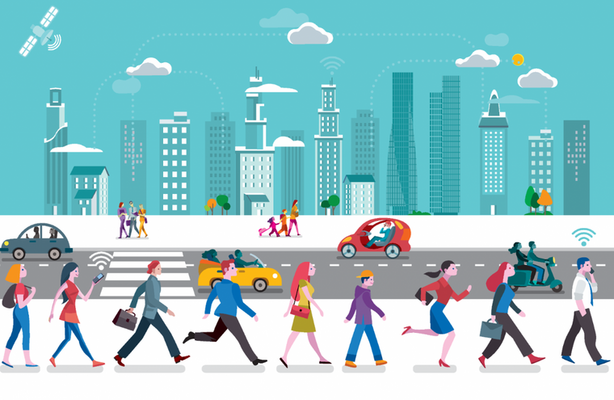Print
Posted By
on 03/15/2024
Beyond the App: Integrating Ride Sharing with Smart Cities

The rise of smart cities presents an exciting opportunity to reimagine urban mobility. One key player in this transformation is the ride-sharing industry. By seamlessly integrating ride-sharing apps with smart city initiatives, we can create a more efficient, sustainable, and user-friendly transportation ecosystem.
Smart Cities: A Connected Ecosystem
Smart cities leverage technology to optimize resources and infrastructure. This includes interconnected sensors, real-time data collection, and intelligent traffic management systems. Ride-sharing apps can become vital cogs in this machine by enhancing transportation efficiency and reducing congestion, a key consideration for those looking to create a taxi app like Uber:
- Real-Time Traffic Data Integration: Imagine ride-sharing apps with access to real-time traffic data feeds from smart city infrastructure. This allows for dynamic routing, suggesting the most efficient routes to drivers, avoiding congestion and minimizing travel times for passengers.
- Public Transportation Integration: Seamless integration with public transportation systems is another exciting possibility. Users could view real-time bus schedules, plan multi-modal trips combining ride-sharing with public transit, and even purchase integrated tickets through the ride-sharing app.
- Connected Vehicle Communication: As connected vehicle technology advances, ride-sharing apps can leverage communication between vehicles and smart city infrastructure. Imagine cars receiving real-time information on traffic lights, road closures, or available parking spots, optimizing overall traffic flow and reducing congestion.
Benefits of Ride-Sharing and Smart City Integration:
This integration offers numerous benefits for both riders and smart cities:
- Reduced Traffic Congestion: By providing real-time traffic data and optimizing routes, ride-sharing apps can contribute to smoother traffic flow. This reduces travel times, lowers emissions, and improves overall air quality.
- Improved Public Transportation Utilization: Integration with public transport systems encourages multi-modal journeys, making public transportation more user-friendly and accessible for those needing shorter ride segments at the beginning or end of their trips.
- Enhanced User Experience: Passengers benefit from a seamless experience, planning and booking multi-modal trips with ease. Real-time updates and optimized routes ensure faster commutes and more predictable travel times.
- Data-Driven Decision Making: By analyzing ride-sharing data, smart city authorities can gain valuable insights into transportation patterns, allowing them to optimize infrastructure development and public transportation offerings.
Challenges and Considerations:
Several challenges need to be addressed for successful integration:
- Data Privacy Concerns: Sharing real-time traffic data might raise data privacy concerns. Clear regulations and transparency regarding data collection and usage are essential.
- Standardization and Interoperability: Different smart city initiatives and ride-sharing companies may use varying technology platforms. Standardization is crucial to ensure seamless communication and data exchange.
- Public-Private Partnerships: Effective collaboration between ride-sharing companies, city authorities, and public transportation providers is key to overcoming infrastructure and regulatory hurdles.
Looking Ahead: The Future of Ride-Sharing in Smart Cities
The future of ride-sharing in smart cities is bright. Here are some potential advancements:
- Micro-Mobility Integration: Ride-sharing apps can integrate seamlessly with bike-sharing and scooter-sharing services, offering users a variety of options for short-distance travel based on their needs.
- Autonomous Vehicles and Ride-Sharing: As autonomous vehicle technology matures, integration with ride-sharing platforms could revolutionize urban mobility, offering on-demand self-driving car options and further optimizing traffic flow.
- Personalized Mobility Planning: Imagine ride-sharing apps connected to personal calendars and location services. They could suggest the most efficient mode of transportation for each trip based on real-time traffic conditions, user preferences, and destination urgency.
Conclusion:
By integrating with smart city initiatives, ride-sharing apps can play a pivotal role in building more efficient, sustainable, and user-friendly transportation systems. Collaboration between public and private entities, coupled with technological advancements, will pave the way for a future where urban mobility is seamless, data-driven, and caters to the evolving needs of city dwellers. This integration has the potential to transform our cities into connected ecosystems where ride-sharing becomes a vital cog in the wheel of smart and sustainable urban transportation.
